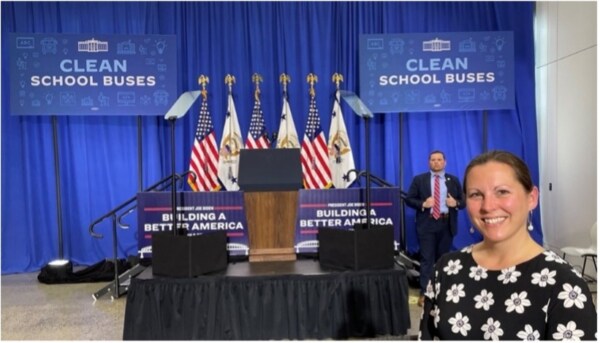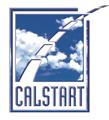How Industry Veterans Can Help School Districts Navigate the Transition to Electric School Buses
By Jared Schnader and Rachel Chard
Friday’s opening of $500 million for the Environmental Protection Agency’s (EPA’s) 2022 Clean School Bus Rebates is the result of decades of work from industry and policy advocates like CALSTART to drive the market forward for electric school buses (ESBs). Estimated to replace 10% of the nation’s 500,000 school bus fleet with low- and zero-emission buses, this first wave of funding (out of a total of $5 billion from the Bipartisan Infrastructure Law (IIJA)) will aide communities and school children disproportionally burdened by poor air quality and harmful toxins emitted from diesel-powered school buses—under IIJA, EPA may prioritize applications for new buses that will serve high-need local education agencies, Tribal Schools, and rural areas.

CALSTART VP of Policy Jes Olson attending the $500 million funding announcement.
CALSTART worked with the Biden Administration on the Clean School Bus Program to tackle the challenge of upfront ESB costs for the largest public transportation network in the country. CALSTART provided insight on effective program strategies that help eliminate some of the funding challenges school districts have with current EPA programs. The Clean School Bus Program’s hybrid funding model of using purchase orders in the rebate process is in part based on CALSTART’s experience administering California’s Hybrid and Zero-Emission Truck and Bus Voucher Incentive Project (HVIP) and advocating for the creation of the Federal Transit Administration’s Low No program, in addition to feedback CALSTART has received from listening sessions with school districts across the country. This hybrid approach is critical for school districts: rather than requiring they pay the cost of ESBs with their own funds upfront – a significant barrier to ESB adoption – awarded districts can submit a purchase order for both the bus and infrastructure, and the EPA will provide the funds upfront for the school districts to pay invoices directly to dealers and contractors.
Funding distribution in a manner more favorable to typical school district purchasing and procurement procedures is one concern the Clean School Bus Program has addressed, but the next, and arguably more crucial concern, is for school districts to get access to planning and technical assistance to make this transition effective and efficient. (The Clean School Bus Program does not currently include a technical assistance service option.) Advanced preparation is especially important given that the EPA will also focus education and outreach efforts to underserved communities that may have never gone through the process of applying for a federal grant or rebate. To experience a smoother transition to electrification, and to save money and time, school districts should be encouraged to partner with clean transportation organizations like CALSTART to plan ahead with ESB manufacturers, connect with their local utilities on charging infrastructure, and develop workforce support for their currently employed bus drivers and mechanics. New technology adoption has inherent challenges—enlisting the services of a technical advisor can help school districts avoid potential issues and troubleshoot more effectively, which will be imperative to ensure positive ESB adoptions and sustain industry momentum.
Applications for this first round of competitive funding are available until August 19, 2022, but Clean School Bus competitions funded by IIJA will be held every year for the next five years. To ensure that IIJA funds for ESBs are utilized with utmost confidence in success, school districts need actionable transition plans that break down the following topics:
- Vehicle Replacement Plan
- Infrastructure Plan
- Proposed Vehicle Charging Plan
- Estimated Electricity Demand
- Funding and Incentive Opportunities
- Policy and Legislation Considerations
- Workforce Development
CALSTART, in partnership with World Resources Institute (WRI), promotes this planning process in our ongoing Electric School Bus Working Groups. In working groups that are open to all U.S. school districts, CALSTART connects with districts to pinpoint hurdles to adoption, collaborate on solutions, and prepare participants for the challenges and benefits of reducing emissions in our communities. CALSTART will be using these working groups to discuss transition plan topics and help guide school districts through the process of adoption by encouraging them to explore each of the transition plan topics above in relation to their fleet. Following a final National ESB Working Group this June, CALSTART will begin hosting Regional ESB Working Groups thanks to funding from WRI:
- Northeast Region – EPA 1,2,3
- Midwest/Mountain Region – EPA 5,7,8
- South/Gulf Coast Region – EPA 4,6
- Pacific Region – EPA 9,10
CALSTART will also host an industry working group for community colleges, dealers, and original equipment manufacturers to provide education, learn about school districts’ challenges, and discuss workforce development; we are also exploring how to encourage policy at the state level to support the ESB industry through adoption goals and more localized funding sources.
At the state level, CALSTART hosts the California Electric School Bus Working Group, which is funded by the California Air Resources Board (CARB) through the HVIP Public School Bus Set-Aside for Small and Medium Air Districts. Through this working group, we will be providing technical assistance and aim to develop transition plans for school districts in California to jumpstart their planning process and prepare them to apply for federal, state, and local funding opportunities when they become available. By helping districts identify their charging infrastructure strategy, the right vehicles, duty cycles, energy needs, and additional resources and funding, these transition plans can be used to show utilities the energy demands required for fleet electrification.
To connect with CALSTART on our ESB Working Groups and other ESB communications, please add your contact information here:
CALSTART Resources on ESBs:
Zeroing in on ESBs (Jan 2022)
Map of U.S., number of ESBs by state
Map of U.S., number of ESBs by EPA region
Fact Sheet 1: 7-Step Checklist for School Districts to Transition to Electric School Buses
Fact Sheet 2: Summary of ESB Demonstration Case Studies
